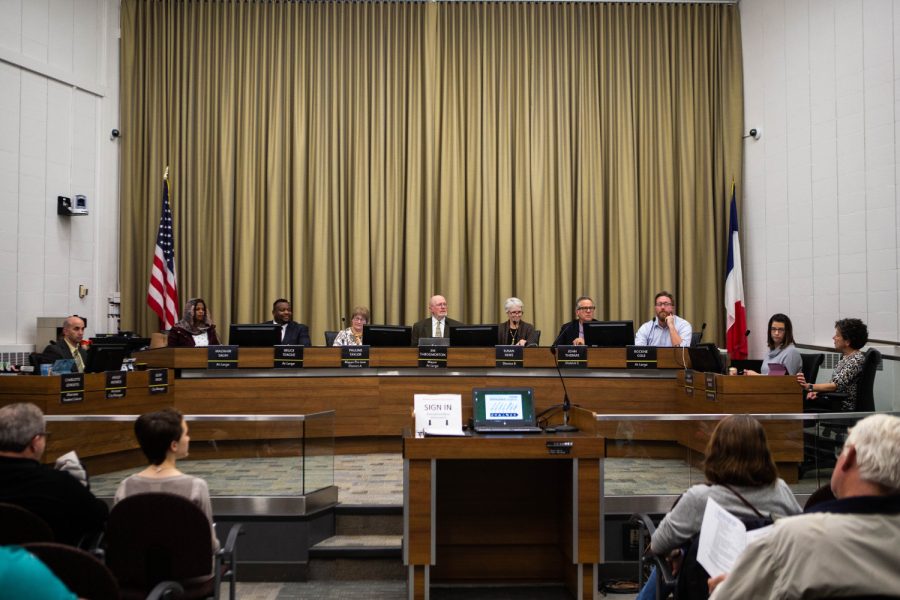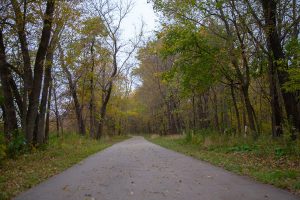Iowa City City Council OKs construction project for intersection of Burlington and Madison Streets
Iowa City city councilors raised concerns regarding the construction plans to the intersection of Burlington and Madison Streets. The concerns focused on the safety of bicyclists with a motion passed unanimously.
Iowa City Mayor Jim Throgmorton calls a City Council meeting to order at City Hall on Monday, November 4, 2019.
November 4, 2019
The Iowa City City Council on Monday unanimously passed a motion to widen the intersection of Burlington and Madison Streets on Monday.
The council’s passage of the intersection-improvement proposal followed a public hearing to consider the project. Continuous buffered-bike lanes will be implemented at the intersection and crosswalks will be improved to increase pedestrian safety, according to City Council documents. Improvements are set to cost approximately $1.4 million.
Cedar Rapids-based surveying company Anderson-Bogert Engineers began the improvement designs in 2010. City Council documents show that initial plans included street-lighting improvement and landscaping; however, those ideas were put on hold because of unforeseen factors.
During Monday’s public hearing, City Councilor Rockne Cole raised concerns about the number of pedestrians near the University of Iowa Campus Recreation and Wellness Center and how that relates to high vehicle traffic.
Burlington and Madison Streets are main roads of transit to get to the west side residence halls, medical, and sports complexes. These traffic factors were considered during the hearing as well, city councilors said.
Iowa City senior engineer Jason Reichart, who worked on the project, spoke to the council about the project. He said the city will pull back from its intent to make Madison Street a three-lane road because of university construction currently in that area.
Cole stated his preference for bike lanes but raised concerns about bike lanes extending all the way to Riverside Drive from Burlington and Madison Streets and the potential dangers that could entail.
Reichart said he could not address concerns about whether or not there was anything to protect bicyclists when crossing the bridge at Burlington Street.
As Iowa City’s biking population continues to grow, city officials emphasized the need for more regulations behind it. As previously reported by the DI, Iowa City Assistant Transportation Planner Sarah Walz said people are safer riding on the street than the sidewalk.
The recent addition of bike-only lanes on Clinton Street aims to make bicyclists feel safer and make riding safer. The bike lane reserves a space on the road and also calls attention to motorists that there will be bikes on the road — if they didn’t notice already, Walz said.
City Councilor Susan Mims added in that only “paint” would protect the bicyclists.
“It is doing this or having nothing at all,” Mims said. “Then we have bicyclists riding in the same lanes with vehicles.”
Mims asked the engineers at the hearing whether they would consider putting in posts to block off the bike lanes in order to allow cyclists time to adjust to the additional lane.
RELATED: Iowa City addresses safety of children biking on the road
All seven of the city councilors said there should be some coloring or distinction of these bike lanes on Burlington Street that extend across the river.
“I want to know what the bike community says [in writing] about this project,” Mayor Jim Throgmorton said.
Other city councilors said the bicyclist community has verbally shown its support.
The City Council also asked questions about the Burlington and Madison Street improvements in relation to the construction of the new UI Stanley Museum of Art building occurring at the corner of the intersection.
Construction for both the Stanley Museum of Art and Burlington and Madison Streets improvements would overlap. The intersection is projected to be completed by fall 2020 and the museum is expected to be finished by spring 2022.





